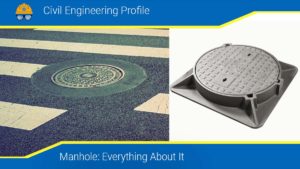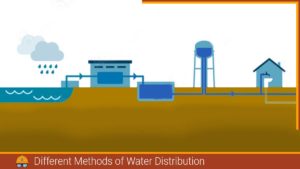The soak pit is one of the common methods of disposing of effluent in nature where the municipal sewer treatment system is absent. The soil absorption system involves the disposal of effluent on land and can be adopted only when sufficient land is available and the soil is sufficiently porous to give a percolation rate not exceeding 60 minutes. The percolation of soil or ground is defined as the time in minutes required for seepage of water through that ground by 1 centimetre. A higher percolation rate naturally would reflect less porous soils.
In the case, that sufficient porous ground is not available, the effluent of the septic tank shall be subjected to a secondary treatment either in a biological filter or in an up-flow anaerobic filter, before its final disposal either in a city sewer or drain or gardening purpose.
Soil Absorption System:
Depending upon the position of the subsoil water level, and soil and subsoil conditions, the method of disposal of the effluent is recommended. Soil Absorption systems may be constructed in two different types as follows:
- Soak pit or Seepage pit: It is constructed when the subsoil water level is below 1.8m from the ground level.
- Dispersion trench: It is chosen when the subsoil water level is within 1.8m from the ground level.
What is Soak Pit Or Seepage Pit?
A soak pit is part of a sewage treatment system that allows effluent (liquid waste) to be gradually absorbed or soaked into the surrounding soil. It is also known as a seepage pit due to the absorption mechanism of the ground. It is typically used in areas where a centralized sewer system is not available or feasible. The purpose of a soak pit is to facilitate the natural filtration and biological degradation of the waste, preventing pollution of the environment.
Soak pits are constructed when the subsoil water level is below 1.8m from the ground level and when the percolation rate does not exceed 30 minutes. If the percolation rate exceeds 30 minutes but is less than 60 minutes, it is not recommended to construct a seepage pit in the area.
There are two common designs for soak pits: one with stone aggregate filling (unlined type) and the other left empty (lined type). In the first design, the pit is filled with a layer of stone aggregate. This aggregate acts as a filter, allowing the effluent to slowly seep into the soil while trapping solid particles. To prevent surface runoff from flooding the pit, a masonry ring is constructed at the top.
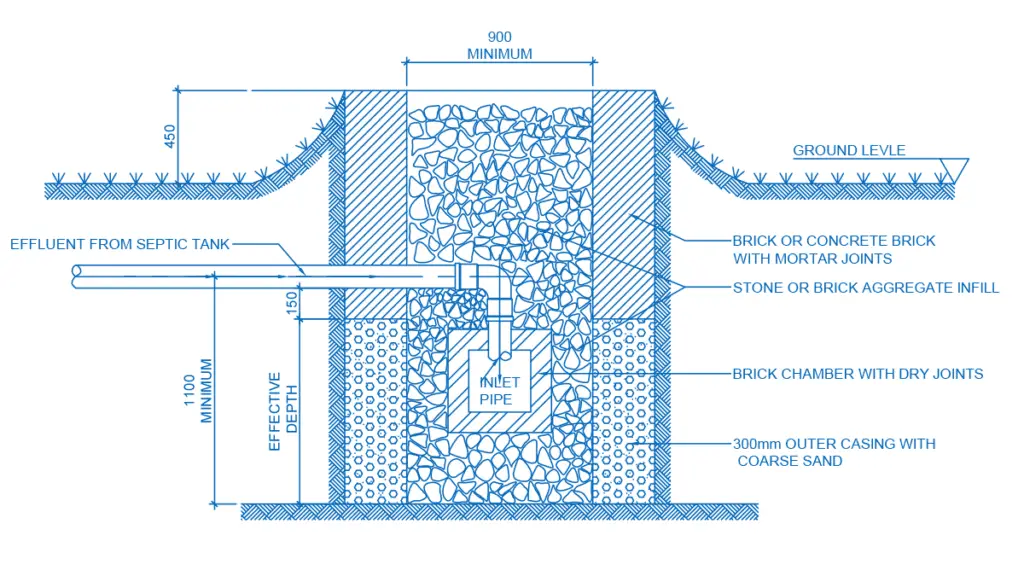
In the second design, the soak pit is left empty, but it is lined with brick, stone, or concrete blocks with dry open joints. This lining provides structural support and prevents soil erosion. The lining is placed below the inlet level, and a 7.5 cm thick backing of coarse aggregate supports it. Above the inlet level, the lining is plastered with cement mortar to ensure a watertight seal. A concrete slab with a manhole opening is provided at the top.
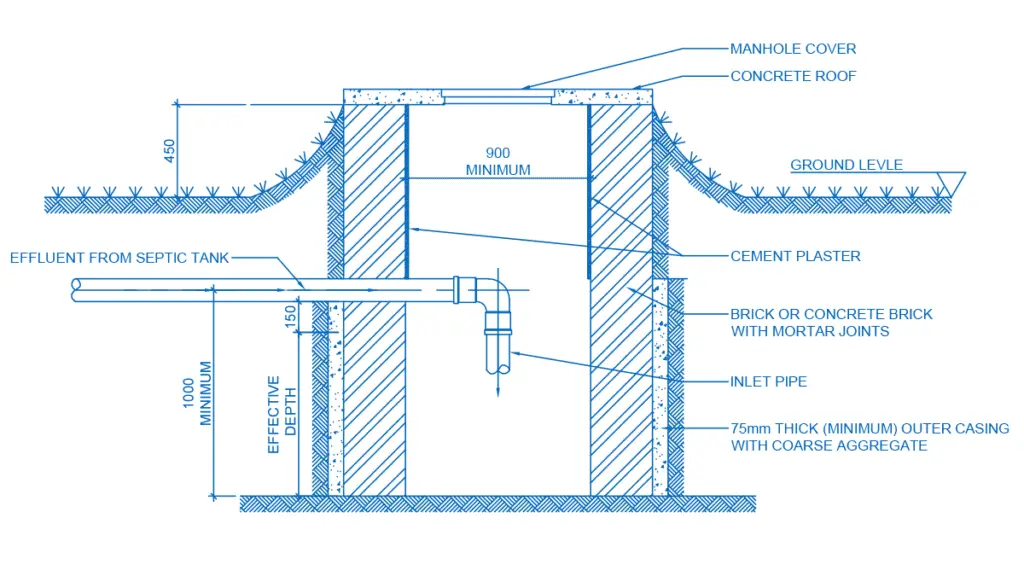
Also, read: How to Design a Septic Tank? | Septic Tank Design | Design of Septic Tank
In both designs, an inlet pipe is used to direct the wastewater into the soak pit. As an anti-mosquito measure, the inlet pipe is usually taken down to a depth of 0.9 m from the top. This depth helps prevent mosquitoes from breeding in standing water.
The primary function of a soak pit is to allow the effluent to percolate slowly into the soil, where natural processes can help purify it. The soil acts as a filter, removing contaminants and harmful bacteria through physical, chemical, and biological processes. This gradual absorption also helps prevent groundwater contamination.
To ensure proper disposal in soak pits, it is important to have highly porous underground soil that allows for rapid percolation of wastewater. Ideally, the percolation rate should not exceed 30 minutes. This ensures that the effluent is absorbed efficiently into the soil, preventing the pit from becoming overwhelmed and minimizing the risk of surface runoff or groundwater contamination. The high porosity of the soil enables quick filtration and natural purification processes, contributing to effective waste management.
Also, read: Advantages and Disadvantages of Septic Tanks
Dispersion Trenches
This method involves the diversion of septic tank effluent into a masonry chamber known as a distribution box. From there, the effluent is evenly distributed through an underground network of open jointed pipes into absorption trenches called dispersion trenches. These trenches are filled with gravel and well-graded aggregate, serving as a medium for the absorption of suspended organic matter present in the effluent.
As the effluent percolates through the dispersion trenches, the clear water gradually seeps down into the water table, allowing for natural filtration and purification processes. On top of the absorption trenches, plants are typically grown. These plants benefit from the capillary action, drawing water from the seeping effluent in the trenches to fulfil their irrigation needs.
By utilizing this method, the septic tank effluent undergoes a process of filtration, organic matter absorption, and gradual recharge of the groundwater table. This helps in the effective treatment and management of wastewater while providing water for plant irrigation, contributing to a sustainable and eco-friendly approach.
It is not advisable to construct such trenches in areas where the fibrous roots of trees or vegetation are likely to penetrate the system and cause blockages.
When selecting and planning to construct such trenches, it is essential to ensure the soil has a percolation rate within the acceptable range of 60 minutes or less. This ensures that the wastewater can infiltrate the soil at a suitable pace, preventing oversaturation and promoting effective absorption and filtration.
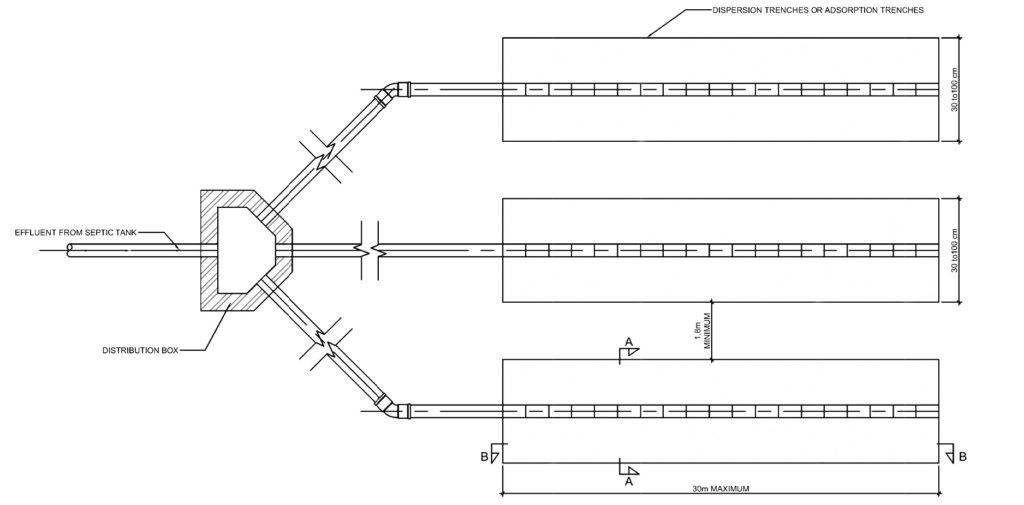

Also, read: What Is The Difference Between S-Trap And P-Trap?
FAQs:
Q: What are the designs of the soak pit?
Ans: There are two types of soak pit designs which are a Lined soak pit and an Unlined soak pit that can be employed according to onces need.
Q: What should be the distance between a septic tank and a soak pit?
Ans: The distance between a septic tank and a soak pit, also known as a leach field, can vary depending on various factors such as local regulations, soil conditions, and the size of the septic system. However, the distance is recommended to be at least 3 meters (10 feet).
Q: What should be the size of the dispersion trenches?
Ans: The size of the dispersion trenches should be 0.5 to 1.0 m in depth and 0.3 to 1.0 m in width. Its length should not be longer the 30 m.
Q: What should be the spacing between each dispersion trenche?
Ans: The minimum spacing between each dispersion trenche is 1.8 m and the maximum is 2.0 m.
References:
- IS2470-2 (1985). Code of Practice for Installation of Septic Tanks. (2nd Rivision) Indian Standard.BIS. New Delhi. 110002
- Garg, S.K. (2010). Water Supply Engineering (35th ed.). Environmental Engineering. Vol.-I. Khanna Publishers. Daryaganj, New Delhi-110002.
![]()






